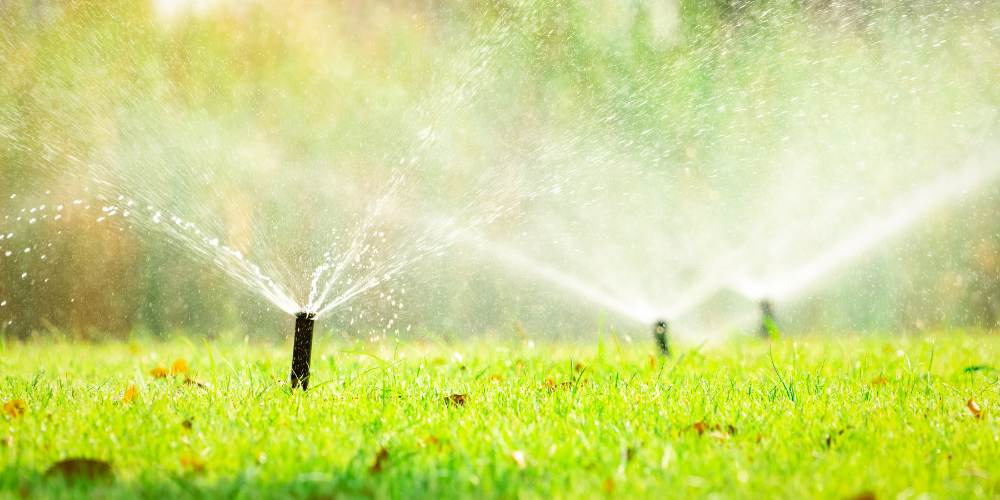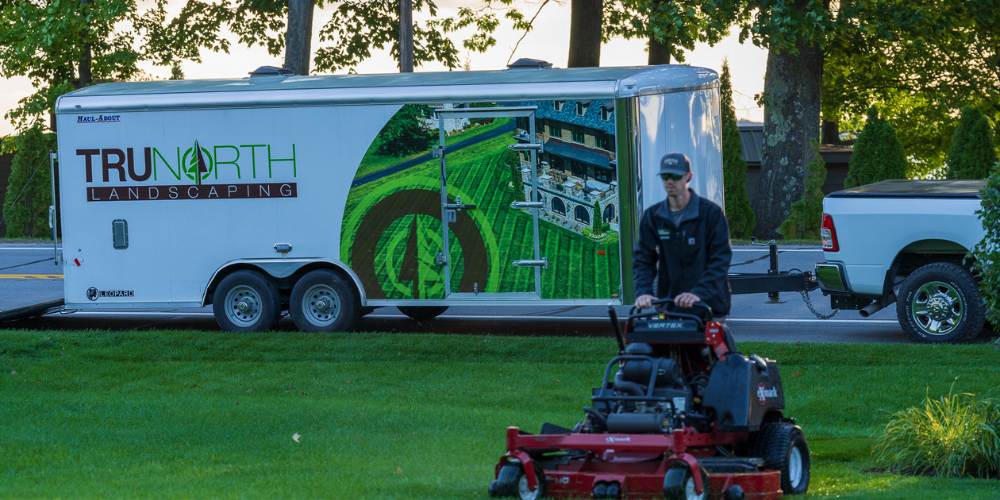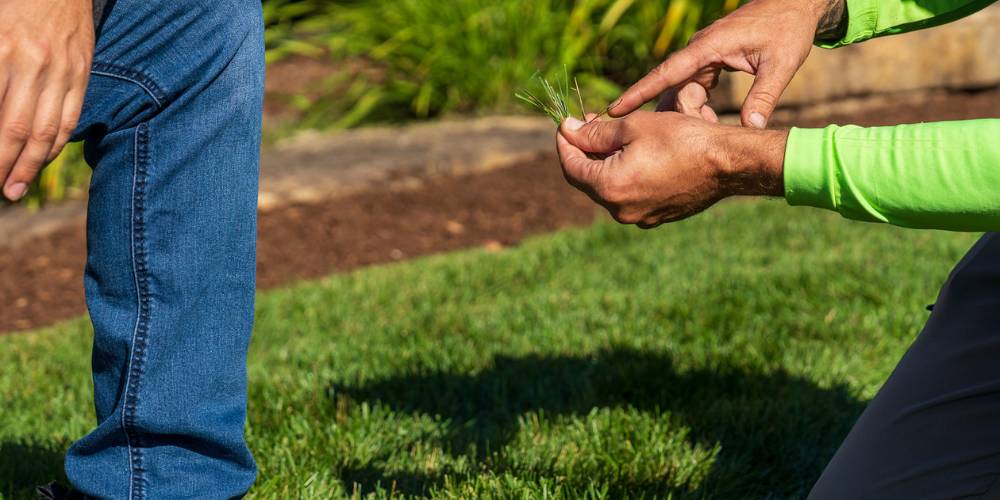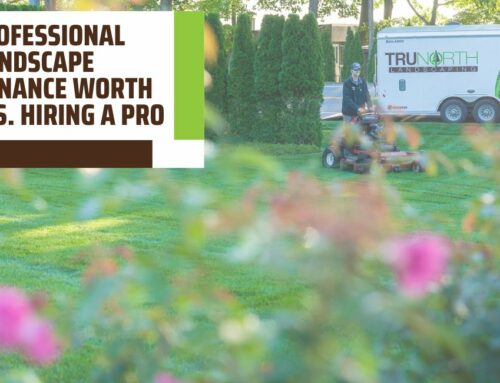As spring arrives in Northern Michigan, many homeowners are greeted by a less-than-inspiring view outside their windows—brown grass, bare landscape beds, and leafless trees. After a long, harsh winter, your once-thriving lawn may look like it’s seen better days. But don’t despair! Reviving your yard this spring is not only possible, but it starts with understanding and dispelling some common myths about lawn care.
By tackling these five myths head-on, you’ll set your lawn up for success and ensure it thrives throughout the spring and summer seasons.
Learn More About:
Myth 1: My lawn will bounce back on its own
Myth 2: April showers are enough water for my lawn
Myth 3: I only need to fertilize once or twice a year
Myth 4: Cutting my grass shorter will make it grow back faster
Myth 5: Insects and lawn diseases are just a nuisance
Myth #1: “My lawn will bounce back on its own”
If the snow arrived before you had a chance to rake up last year’s leaves or grass clippings, you might assume that your lawn will recover on its own once the snow melts. Unfortunately, that’s not the case. One of the most crucial steps in reviving your lawn in spring is clearing away the debris left from last year. Matted leaves and grass can suffocate your lawn, preventing new growth.
Start by using a hard rake to remove any dead grass, leaves, and other debris that accumulated over winter. If certain areas of your lawn look patchy or bare, use the rake to loosen the soil, which will help new grass seed take root and allow fertilizers to penetrate better. While this myth can be avoided with a thorough fall cleanup, it’s never too late to give your lawn the fresh start it needs.

Myth #2: “April showers are enough water for my lawn”
Springtime rains are certainly beneficial, but they’re not enough to keep your lawn healthy and green—especially if it’s coming out of winter looking dry or lifeless. While northern Michigan typically gets a fair amount of spring rainfall, your lawn may need a little extra help.
Lawns generally need about 1-2 inches of water per week, and this amount should increase as temperatures rise in the summer months. If your grass is looking particularly crispy or brown, increasing your watering schedule can help bring it back to life. Watering early in the morning—before sunrise—is ideal, as it allows the water to soak into the soil without evaporating in the midday heat. Proper watering is one of the simplest yet most effective ways to maintain a lush, green lawn throughout the growing season.

Myth #3: “I only need to fertilize once or twice a year”
Fertilizer is one of the most underutilized tools when it comes to lawn care, and many people mistakenly believe that applying it once or twice a year is enough. In reality, fertilizing your lawn multiple times throughout the year is essential to promoting healthy growth and preventing nutrient deficiencies.
A proper fertilization schedule includes at least 3-5 applications throughout the growing season, starting in early spring to kickstart new growth. Using the right type of fertilizer for your lawn’s specific needs is just as important. Organic and slow-release fertilizers are great options for those looking for eco-friendly solutions. Be sure to follow the instructions carefully to avoid over-fertilizing, which can burn your lawn and lead to uneven growth.
Using a spreader is crucial for even application—otherwise, you might end up with a “striped” lawn where certain areas are over- or under-fertilized. If you’re unsure about how much or how often to fertilize, it may be worth consulting with a lawn care professional to ensure you’re giving your lawn the nutrients it needs to thrive.

Myth #4: “Cutting my grass shorter will make it grow back faster”
It’s a common misconception that cutting your grass shorter will encourage it to grow back faster or healthier. In fact, cutting your grass too short can have the opposite effect, making your lawn more susceptible to stress and disease. When you mow too short, you remove more of the grass blade than necessary, which reduces the plant’s ability to photosynthesize and produce food for itself.
To maintain a healthy lawn, set your mower blades higher and aim to leave your grass about 3-4 inches tall after each mow. This encourages deeper root growth and helps your lawn retain moisture, especially during the hotter months. While you may need to mow more frequently, your grass will be healthier and more resilient in the long run. And if possible, leave your clippings on the lawn to serve as natural fertilizer—they’ll break down and return valuable nutrients to the soil.
Finally, make sure your mower blades are sharp. Dull blades tear the grass rather than cutting it cleanly, which can lead to ragged, brown edges that make your lawn look unhealthy. Sharpen your mower blades at least once a year for the best results.

Myth #5: “Insects and lawn diseases are just a nuisance”
It’s easy to dismiss insects and lawn diseases as minor annoyances, but left untreated, they can cause significant damage to your lawn. Pests like grubs, chinch bugs, and armyworms can chew through your grass, leaving large brown patches in their wake. Meanwhile, diseases like brown patch, dollar spot, and rust can spread quickly, killing off your lawn in a matter of weeks.
To protect your lawn from these threats, it’s important to stay vigilant and address problems at the first sign of trouble. Keep an eye out for signs of insect activity, such as small mounds of dirt or areas where the grass has been chewed down to the roots. If you notice any symptoms of lawn diseases, such as discolored patches or a white powdery substance on the grass, act quickly to prevent further damage. There are many effective treatments available, including both chemical and organic options.
Partnering with a lawn care professional can help you stay ahead of these issues and ensure that your lawn stays healthy and vibrant throughout the season.

Take the Guesswork Out of Lawn Care: Call in the Professionals
Revitalizing a lawn after a harsh Michigan winter can be a daunting task, especially when you’re up against common misconceptions about lawn care. While it’s possible to tackle these issues on your own, sometimes it’s best to leave it to the experts.
A professional lawn care team can help you develop a customized plan to get your lawn back into shape, ensuring it receives the right amount of water, nutrients, and care throughout the year. From early spring cleanups to regular mowing, fertilization, and pest control, professionals have the expertise and tools to keep your lawn looking its best.
At the end of the day, a beautiful, healthy yard is more than just a source of pride—it’s a place where your family can relax, play, and enjoy the outdoors. So, whether you’re struggling with brown patches, overgrown grass, or lawn diseases, don’t hesitate to reach out for help. A thriving lawn is well worth the effort, and with the right care, you’ll be enjoying a green, lush yard in no time.
If you’re ready to give your lawn the care it needs this spring, contact us today to learn more about our lawn maintenance services and how we can help bring your yard back to life.
Image Source: Canva Professional Free Image Use (Header, Sprinkler Head), All Other Images Property of TruNorth Landscaping
Get started today with a consultation!
Want tips and tricks for your lawn & landscaping?
Sign Up For Our Free Quarterly Newsletter
We take your personal information very seriously. We will not share any of the information you provide with any 3rd parties. Provided information will be used specifically to contact you in regards to your inquiry.






